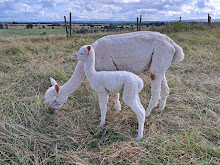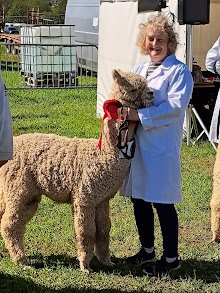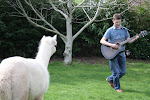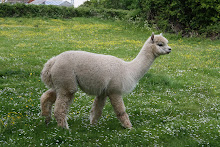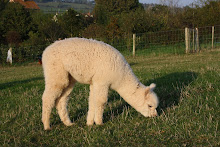I had been told that the Ellingham and Ringwood Show, near Ringwood Hampshire, on the edge of the New Forest was a nice show, and well attended, and that was exactly how I found it to be. A beautiful day beckoned at 5.15 when I got up, and set off just before 6, for the 2-hour drive. It took another quarter of an hour to cross the vast estate to the site of the show, but as always, a good-humoured bunch of alpaca owners, and show organizers, in this case Viv & Andy Redwood, and Rosemary & Carl Aylett were there to greet me.
 |
| Supreme Champion - Artwork Mischief |
There are always a few breeders that need a bit of help in the show-ring, or just handling their alpacas to and from the ring, so I got involved with those, as my two entrants were not due to show until late, being in the white classes. Garry Naish's team wound themselves up into a frenzy by running up and down the trailer ramp to and from the pen, and one of them sneeked out of the pen, deciding to explore the site, but Andy Walker.charmed the alpaca into giving up it's short-lived freedom. Another breeder needed a colour check of one of her team, entered as grey, and an 'independant handler was required, so I took the animal to show-judge Nick Harrington-Smith, who declared it an appaloosa. Andy Walker of Reddingvale needed an extra handler for his Intermediate Black Male, Shylock, and I was pleased to don the white coat for him. Now Shylock is a sweet boy, but has a short attention span, and likes to draw attention to himself - and so one minute he would rest his chin on my chest and gaze into my eyes, and the next, he would drop to the floor and roll around or play dead - highly entertaining for the crowd of onlookers, but I imagined judge N.H-S already marking us down before getting to us (I joke: if you are not an alpaca owner, animal behaviour isn't taken into account). As it happened, Shylock was awarded first place, and as Nick talked about Shylock auditioning for acting roles, he duly dropped and rolled, as if he was listening, to much hilarity!
Well our turn eventually came, but unfortunately, neither Apple Vale Fortune who had been shorn seven weeks earlier (and the shearer had left a bit of length on), or Apple Vale Gala, had sufficient fleece length for Nick ("I'm struggling here") to compare with the others in the class, so they didn't get in the 'medals'. Nevertheless after three full-fleece shows, Fortune remained un-beaten, and has his 2nd place in the National Show on his C.V. Given the wild weather last saturday, we had a smashing day, with thanks to the organizers for their hard work.
 |
| Reddingvale Valentina ('Blossom', to us), with 'Harvey' (Apple Vale Doctor Harvey) |
Back on the farm, with an unfortunate birthing season, we identified a shortage of light fawn fleece for the craft studio, and so after some searching, we found Reddingvale Valentina (Grand-sire ILR Alpines Fibre Brutus) , with her cria, sired by Wimmera Skies Class Act, (whose progeny have won many classes this year) who she is again mated to, and they have joined us, and settling-in..










